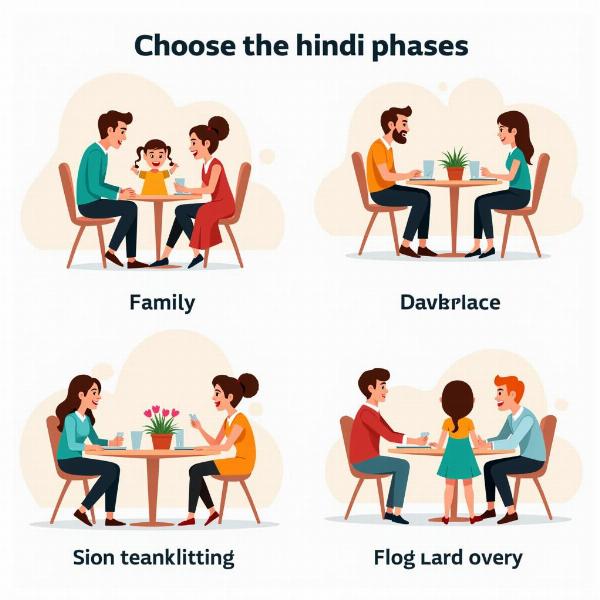Understanding the phrase “good for you” and its nuances in Hindi can be tricky. This phrase, common in English, doesn’t have a single, perfect equivalent in Hindi. Its meaning can shift depending on the context, ranging from genuine happiness for someone’s success to a sarcastic remark about their perceived good fortune. This article will delve into the various ways “good for you” is expressed in Hindi, exploring the subtle differences in meaning and usage. We’ll also look at cultural contexts that influence how this sentiment is conveyed.
Decoding “Good For You”: A Multifaceted Phrase
“Good for you” can be a simple expression of congratulations. However, its meaning can be heavily influenced by tone and context. Imagine a friend telling you they got a promotion. A sincere “good for you” expresses genuine happiness. But, if said with a sarcastic tone, it could imply envy or disbelief. This complexity makes translating “good for you” into Hindi an exercise in understanding nuance.
Expressing “Good For You” in Hindi: Various Shades of Meaning
Several Hindi phrases capture the essence of “good for you,” each with its own subtle connotations:
-
वाह! बहुत ख़ुशी हुई (Vah! Bahut khushi hui): This translates to “Wow! I’m very happy” and is a straightforward way to express genuine joy for someone’s good fortune. It’s suitable for close friends and family.
-
मुबारक हो (Mubarak ho): This is a common congratulatory phrase, equivalent to “Congratulations!” It’s a more formal way to express “good for you” and appropriate for various situations.
-
शाबाश (Shabash): This translates to “Well done!” and is used to praise someone’s achievement. It’s ideal for situations where effort and skill have led to a positive outcome.
-
क्या बात है (Kya baat hai): This translates to “That’s great!” and can be used to express admiration or approval. It’s a more informal and versatile expression.
-
अच्छा हुआ (Accha hua): This literally means “It’s good that it happened,” and can be used when something positive has occurred, even if it’s not a significant achievement.
Cultural Context: Navigating the Nuances
Indian culture often emphasizes humility and downplaying personal achievements. While expressing happiness for others is important, overt praise can sometimes be perceived as boastful. Therefore, choosing the right phrase and tone is crucial. For instance, using a more subdued phrase like “Accha hua” might be more appropriate in some situations than a boisterous “Shabash.”
Sarcasm and “Good For You”: A Delicate Balance
Expressing sarcasm in Hindi requires careful navigation. Tone of voice and facial expressions play a vital role. While direct translations might not convey sarcasm effectively, adding a phrase like “वाह, क्या बात है!” (Wow, that’s great!) with a particular tone can express a sarcastic “good for you.” However, it’s essential to be mindful of the relationship with the person and the situation to avoid causing offense.
When “Good For You” Isn’t So Good: Negative Connotations
Sometimes, “good for you” can be used dismissively or condescendingly. In Hindi, phrases like “तो क्या हुआ? (To kya hua?)” (So what?) or “मुझे क्या? (Mujhe kya?)” (What’s it to me?) can convey similar disinterest or even negativity.
Choosing the Right Phrase: Context is Key
The most appropriate Hindi equivalent of “good for you” depends heavily on the context. Consider the relationship with the person, the nature of the event, and the intended tone. Being mindful of these factors will help ensure your message is conveyed accurately and respectfully.
 Choosing the Right Phrase for "Good For You" Based on Context in Hindi
Choosing the Right Phrase for "Good For You" Based on Context in Hindi
Conclusion: Beyond Direct Translation
Translating “good for you” into Hindi goes beyond simply finding equivalent words. It requires understanding the underlying meaning, the cultural context, and the subtle nuances of the situation. By considering these factors, you can effectively communicate your intended message and navigate the complexities of cross-cultural communication. Mastering these nuances will enhance your understanding of both English and Hindi, and allow you to express yourself with greater precision and cultural sensitivity.
FAQ:
- What is the most common way to say “good for you” in Hindi? While several options exist, “वाह! बहुत ख़ुशी हुई (Vah! Bahut khushi hui)” is a common and generally appropriate choice.
- How can I express “good for you” sarcastically in Hindi? Tone and facial expressions are key. Using a phrase like “वाह, क्या बात है! (Wow, that’s great!)” with a sarcastic tone can be effective.
- Is it rude to say “good for you” in Hindi? Not necessarily, but the specific phrase and tone can make a difference. Choose carefully based on the context and your relationship with the person.
- What if I want to express disinterest or negativity instead of congratulations? Phrases like “तो क्या हुआ? (To kya hua?)” or “मुझे क्या? (Mujhe kya?)” can convey these sentiments.
- How important is cultural context when translating “good for you” to Hindi? Cultural context is crucial. Indian culture often values humility, so choosing a subdued phrase might be more appropriate than overt praise in some situations.
Meaning-Hindi.in is your trusted partner for accurate and culturally sensitive Hindi translations. We offer a comprehensive range of translation services, from business documents to legal texts and website localization. Our expert linguists ensure your message is conveyed effectively in Hindi, respecting cultural nuances and achieving your communication goals. Need help with your Hindi translation project? Contact us today at [email protected] or call us at +91 11-4502-7584. Meaning-Hindi.in is your one-stop solution for all your Hindi translation needs.